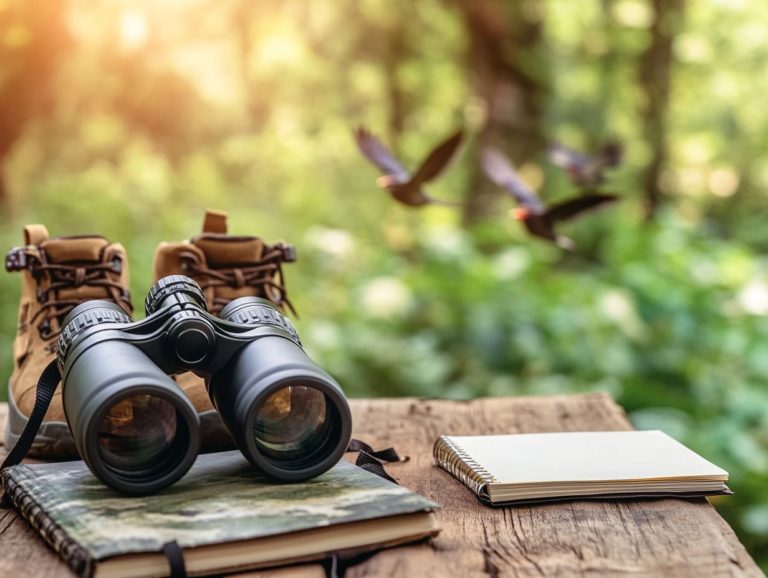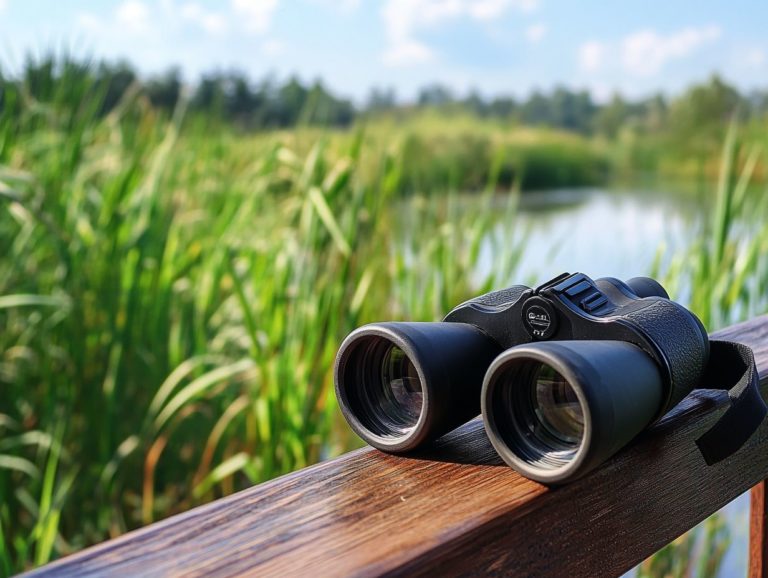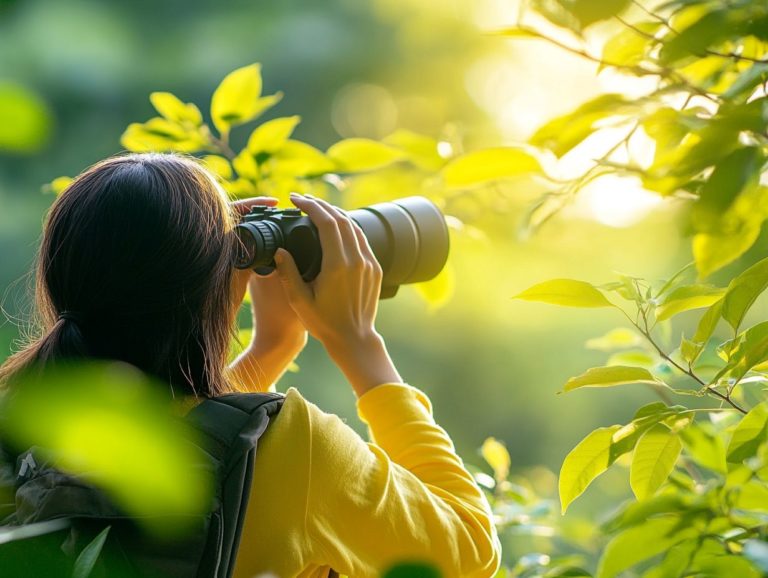What to Look for When Buying Birding Binoculars
Birding binoculars are indispensable tools for nature enthusiasts, transforming your experience by bringing distant birds into vivid clarity.
With many options available, selecting the perfect pair can feel daunting. This guide distills the essential features to consider such as magnification, lens size, and weight empowering you to identify what aligns with your needs.
It looks at various types of binoculars, price ranges, and important factors like brand reputation and warranties. Get ready to take your birdwatching adventures to the next level with these amazing tools!
Contents
- Key Takeaways:
- Key Features to Consider in the Binocular Buying Guide
- Types of Birding Binoculars
- Price Range and Budget
- Additional Considerations
- Frequently Asked Questions
- What to Look for When Buying Birding Binoculars?
- What is the Ideal Magnification for Birding Binoculars?
- Why is the Objective Lens Size Important?
- What is a Good Field of View for Birding Binoculars and What are Some Binocular Features?
- How Important is the Build Quality of Birding Binoculars?
- Can I Use Regular Binoculars for Birding?
Key Takeaways:

- When buying birding binoculars, consider the magnification and objective diameter for a clear, close-up view of birds.
- Pay attention to the prism type, which is the design that affects how light enters the binoculars, impacting image quality. Coatings enhance image quality as well, and consider the weight and comfort for long periods of use.
- Research and compare brands, read customer reviews, and assess warranty and return policies to make an informed decision within your budget.
What are Birding Binoculars?
Birding binoculars are your gateway to a richer birdwatching experience, expertly crafted to meet the needs of birders, professional ornithologists, and nature enthusiasts alike. Thanks to advancements in technology, modern binoculars offer superior optics, an impressive field of view, and optimized light-gathering capabilities, making them essential tools for wildlife observation.
You ll find a variety of configurations, such as 8×42, 7×42, and 10×42. The first number indicates how many times closer the binoculars can make an object appear, while the second number (42) is the diameter of the front lens in millimeters. This allows you to choose the perfect magnification and objective lens size tailored to your viewing preferences.
These binoculars excel at delivering exceptional magnification and image quality, enabling you to spot elusive species from a comfortable distance without disrupting their natural habitats. Their lightweight design means you can carry them effortlessly during long hikes or birdwatching excursions, making them perfect for a range of environments, from dense forests to expansive wetlands.
High-quality optics enhance your ability to identify and appreciate diverse bird species, fostering a deeper understanding of avian life. By elevating your birdwatching experience, these binoculars also play a role in bird conservation efforts; as your awareness grows, you re more likely to support habitat preservation and adopt responsible ecological practices.
Key Features to Consider in the Binocular Buying Guide
Choosing the right pair of birding binoculars requires an understanding of key features that will enhance your experience and satisfaction while observing birds in different environments. Elements such as magnification, objective lens size, field of view, close focus, and prism type can greatly influence your overall experience and the quality of the images you capture.
Consider weight, ergonomics, and durability as well including waterproof designs and coated optics. These factors are vital for birders who depend on reliable performance in varying weather conditions.
Magnification and Objective Lens Size
Magnification and objective lens size are pivotal factors that directly impact the performance of your binoculars, particularly in birdwatching. When you see formats like 8×42, 7×42, or 10×42, these numbers reveal the power of magnification and the diameter of the objective lens in millimeters.
Higher magnification grants you the ability to observe distant birds in greater detail, while larger objective lenses improve brightness and color rendition, making it easier for you to spot and identify various species.
As you select binoculars, consider the type of birding you enjoy, as this will significantly guide your choice of magnification and lens size. For general observation in open areas or parks, a moderate magnification of around 8x combined with a 42mm objective lens provides a wide field of view and ample light for clear images, allowing you to easily track birds in flight.
On the other hand, if your focus shifts to spotting elusive species at a distance, opt for a higher magnification of 10x or even 12x. This increased power may yield a narrower field of view, making stabilization and light-gathering capability essential for maintaining image clarity.
Striking the right balance between magnification and lens size is crucial for enhancing your overall birdwatching experience. Experiment with different models to find the perfect fit for your birdwatching style.
Field of View and Close Focus
The field of view and close focus capabilities of binoculars are essential features that significantly enhance your birdwatching efficiency and enjoyment.
The field of view represents the width of the observable area at a given distance measured in feet at 1,000 yards and is crucial for tracking those swift, darting birds.
Close focus refers to the minimum distance at which your binoculars can focus on an object, allowing you to appreciate the finer details of nearby subjects, such as insects or foliage. This level of detail truly enriches your birding experience.
When you re out birding, having a wide field of view allows you to keep pace with those fleeting subjects, ensuring that no rapid flaps or sudden maneuvers slip by unnoticed. Superior close focus capability is also vital, enabling you to delve deeper into the environment and appreciate the intricacies of feathers or the nuances of bird behavior up close.
For those seeking effective birding tools, it’s wise to explore options that strike a balance between these two features. To optimize your birdwatching experience, consider these practical tips:
- Adjust the binocular strap for maximum comfort.
- Plan each excursion during peak times for bird visibility.
- Try different models before purchasing.
Incorporating these practices transforms each outing into a richer, more rewarding endeavor.
Prism Type and Coatings
The type of prism you choose for your binoculars whether porro or roof along with the quality of the lens coatings, is crucial for determining brightness and overall image quality.
Porro prisms give you a wider field of view and better depth perception, while roof prisms are compact and lightweight, making them ideal for birders who value portability.
Coated optics can elevate your experience even further, enhancing image sharpness, brightness, and color fidelity, ensuring that every birding outing is visually rewarding.
When you’re considering specific birding scenarios, like spotting birds in low light or dense foliage, fully multi-coated lenses become essential. These coatings are game-changers, optimizing light transmission, boosting clarity in challenging conditions and allowing you to catch those fleeting glimpses of elusive species.
On the flip side, while roof prisms offer convenience, they might come with slightly reduced depth perception compared to porro prisms, which can impact your experience during fast-paced birdwatching. It s vital to weigh the pros and cons of each prism type against your unique birding objectives and the environments you frequent.
Weight and Comfort

Choosing the right weight and comfort level is essential for an enjoyable birdwatching experience, as these elements can significantly affect your experience during lengthy viewing sessions.
Opting for lightweight designs that are ergonomically crafted helps minimize fatigue, allowing you to concentrate on spotting and identifying birds without any discomfort.
It’s all about finding the right balance between image quality and weight, especially if you plan to carry your binoculars on long hikes or birding adventures.
To evaluate comfort effectively, assess the grip texture; it should feel secure without any risk of slippage. Test how the binoculars feel when cradled in your hand. The ideal model will feel stable, without any awkward pulling or tilting.
A lightweight option with thoughtful weight distribution will ease strain on your neck and shoulders, making those extended viewing sessions much more enjoyable.
Pay attention to features like padded straps and contoured designs that fit comfortably against your body. Models with built-in thumb indents can further enhance usability, providing better control and reducing muscle fatigue during those long moments of observation.
Durability and Weather Resistance
For serious birdwatchers, durability and weather resistance are key. Waterproof and fog-proof binoculars keep your gear functioning when the weather is unpredictable.
Rugged materials protect against wear and tear. Investing in high-quality binoculars enhances performance and provides peace of mind, allowing you to focus on your birdwatching experience.
Choosing binoculars with special seals that keep out moisture and nitrogen purging is crucial. These features effectively prevent moisture and debris from entering the internal components.
Such advanced designs not only extend the lifespan of your binoculars but also elevate your viewing experience by ensuring clarity, even when temperatures fluctuate.
For dedicated birders, these premium optics are more than just tools; they embody a commitment to observing wildlife seamlessly. Selecting the right features can transform every moment spent in nature into a memorable experience.
Types of Birding Binoculars
Birding binoculars come in various types, each meticulously crafted for your unique needs as a birder. You ll find options like porro prism and roof prism designs, along with compact and full-sized choices.
Understanding the distinctions among these types will help you make an informed decision. This ensures you select perfect binoculars for your pursuits whether you need something portable for fieldwork or the enhanced optical quality that full-sized models provide.
Porro Prism vs Roof Prism
When comparing porro prism and roof prism binoculars, knowing their structural differences is essential. Porro prism binoculars generally offer a wider field of view and superior depth perception, making them ideal for stationary birdwatching.
In contrast, roof prism binoculars have a more streamlined, compact design. This enhances portability, perfect for birders who prioritize lightweight equipment and ergonomic handling.
These design distinctions can significantly influence both image quality and user experience. In situations where detailed observations and close-range viewing are needed, porro prism options may excel because of their enhanced optical performance and greater light-gathering ability.
If you re often on the move hiking through various terrains the lightweight nature of roof prisms becomes a significant advantage.
Ultimately, each type caters to different preferences, whether you value comfort during prolonged use or the ability to adapt swiftly to changing environments. Considering ergonomics and practical usage will guide your selection process.
Compact vs Full-sized
Choosing between compact and full-sized binoculars is about balancing portability with image quality. Each option has its own perks, depending on your birding style.
Compact binoculars are lightweight and easy to carry, making them perfect for travel and casual birdwatching.
Full-sized options typically deliver superior optical performance, brightness, and clarity essential for serious birders who want to spend substantial time observing wildlife.
If you re venturing into dense forests or hiking through rugged terrain, compact binoculars can slip easily into your backpack or pocket without adding bulk.
However, if you revel in the intricate details of distant feathered friends, full-sized binoculars shine in low-light conditions, offering vibrant images even at twilight or dawn.
Both types present unique experiences that allow you to appreciate nature’s wonders, whether on a casual stroll or deeply immersed in dedicated birdwatching. Therefore, selecting the right type of binoculars is crucial for enhancing your overall enjoyment and engagement with the natural world.
Price Range and Budget
Grasping the price range and budget considerations for binoculars is essential for you as a birder aiming to invest in high-quality optics tailored to your specific needs and preferences. The cost of binoculars can fluctuate significantly, influenced by factors like magnification, objective lens size, and how well they work.
Premium brands such as Swarovski and Leica tend to command higher prices, reflecting their advanced technology and renowned performance. Understanding these nuances will empower you to make a well-informed decision that enhances your birdwatching experience.
Factors Affecting Price
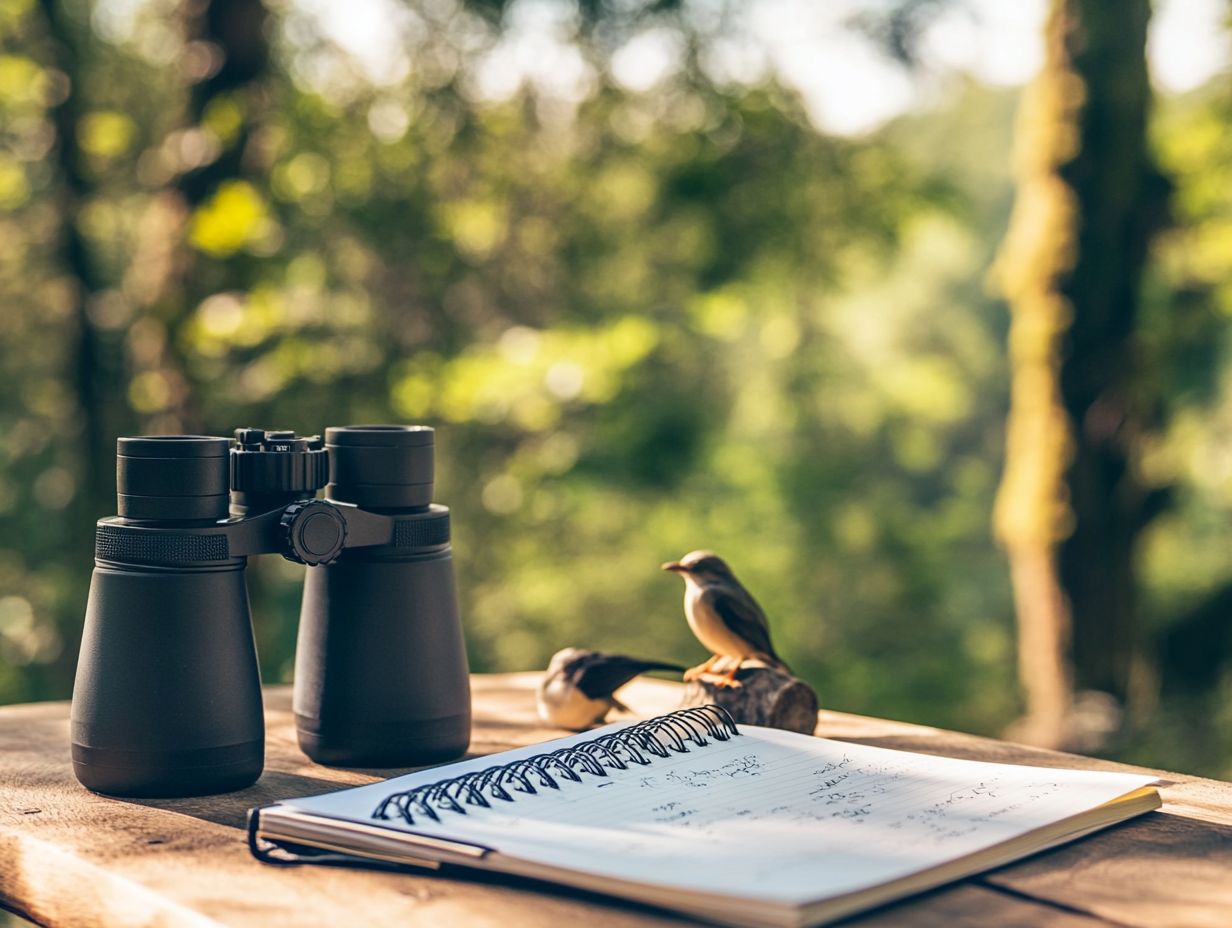
Several factors influence the price of binoculars, ranging from the reputation of the brand to their optical performance, all of which play a crucial role in your decision-making process.
When you’re considering birding binoculars, it’s essential to evaluate specific features, such as the type of prisms used. Roof prisms, while often more compact, can carry a higher price tag due to their intricate design. Coatings that enhance light transmission and minimize glare are vital for getting clear and bright images, often contributing to significant cost differences.
The significance of magnification is important; higher magnification can offer a more immersive viewing experience but may also require a greater financial commitment. Thus, as a discerning birdwatcher, you must strike a balance between value and cost, considering how these optical enhancements, combined with brand reputation, can create pricing variances that resonate with your birding preferences and aspirations.
Additional Considerations
When you invest in birding binoculars, think about factors beyond just the core features. Accessories, warranties, and return policies can significantly influence your satisfaction and overall practicality.
Consider accessories like protective cases and lens cleaning kits. A solid manufacturer s warranty also enhances your peace of mind, ensuring that your investment is well protected and that you get the most out of your purchase.
Brand Reputation and Customer Reviews
When selecting binoculars, focus on brand reputation and customer reviews for quality insights. These factors provide invaluable information about the quality and reliability of the products available. You ll find that renowned brands like Swarovski, Leica, and Canon often shine with high ratings, thanks to their commitment to optical excellence and customer satisfaction, making them preferred choices for serious birders and enthusiasts alike.
As you explore your options, don t just skim the product descriptions; dive into user feedback. This can reveal real-life experiences that showcase both the advantages and potential shortcomings of each model. Expert ratings are equally important; they typically assess features such as magnification, clarity, and durability, helping you align your specific needs with a reputable brand.
By concentrating on trusted reviews and ratings, you can ensure that the binoculars you choose not only match your personal preferences but also deliver lasting value and satisfaction.
Warranty and Return Policy
Understanding the warranty and return policy for binoculars is essential for enhancing your satisfaction and providing peace of mind with your purchase. Most reputable brands offer warranties that cover defects in materials or workmanship for a designated period, ensuring that you can invest in your birdwatching adventures with confidence. A flexible return policy adds an extra layer of security, allowing you to return the binoculars if they don’t meet your expectations.
These warranties can range from one year to a lifetime, reflecting the manufacturers’ commitment to standing behind their products. A thoughtfully crafted return policy, which often permits returns within a specified timeframe, empowers you to explore various options without hesitation.
This combination not only fosters trust but also encourages you to make informed decisions, knowing that support is readily available if your chosen binoculars don t fit your intended use perfectly. Therefore, grasping these terms not only enriches your buying experience but also reinforces your confidence in your purchase.
Accessories and Maintenance
Want to get the most out of your birding binoculars? Choosing the right accessories is key! Investing in accessories and proper maintenance is essential for prolonging the life of your birding binoculars and enhancing your overall experience. Key accessories like lens cleaning kits, protective cases, and harnesses can significantly boost usability and care, ensuring that your binoculars remain in optimal condition for the long haul.
Consider elements like objective lens covers which shield your optics from dust and scratches and tripod adapters that stabilize your views during those extended observations. Regular cleaning is vital. Use microfiber cloths and lens cleaning solutions to maintain clarity. It s also wise to store your binoculars in a cool, dry place to prevent moisture buildup.
By integrating these practices and selecting the right accessories, you ll ensure that your binoculars are always ready for your next adventure!
Frequently Asked Questions
Got questions about birding binoculars? Here are some common inquiries and expert answers!
What to Look for When Buying Birding Binoculars?
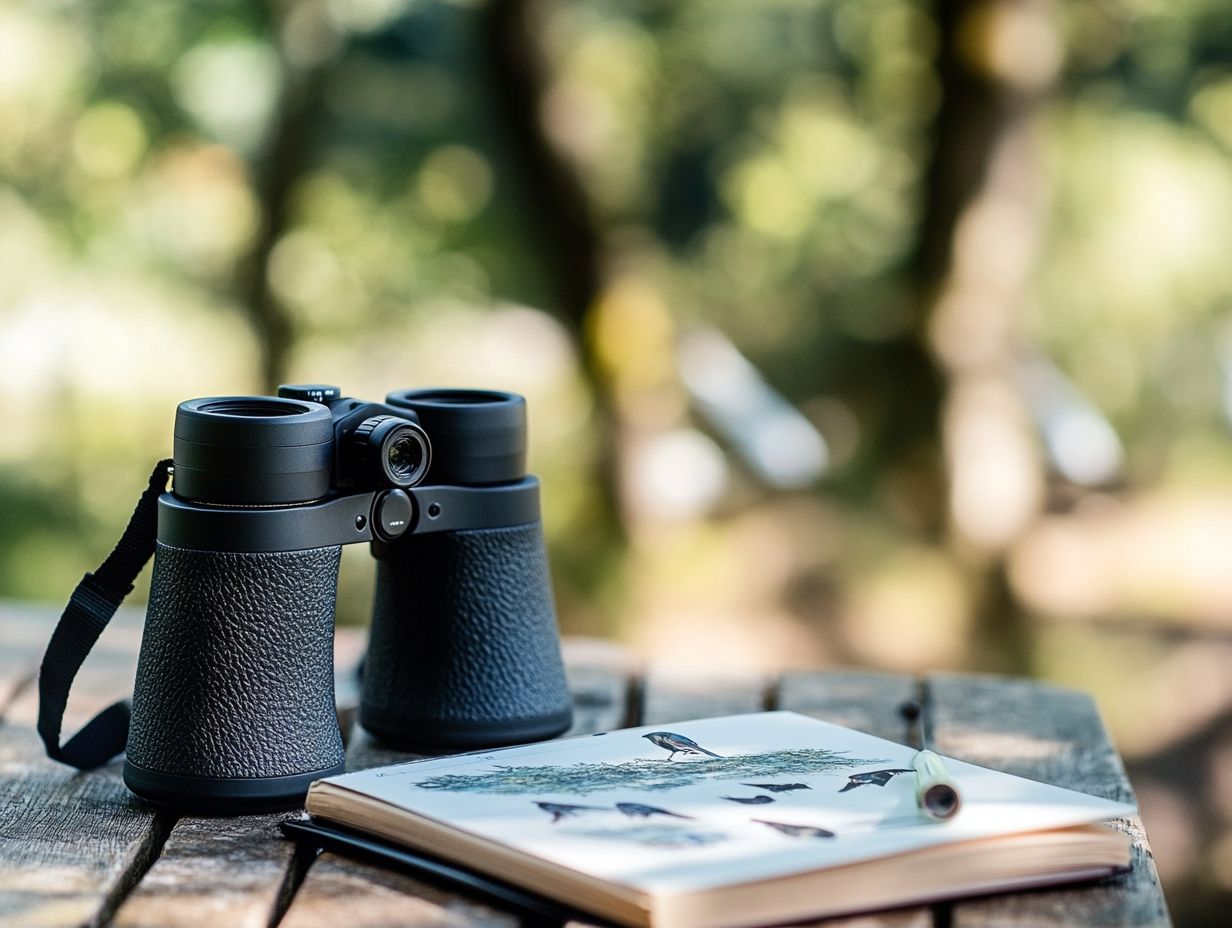
Buying birding binoculars? Here are the key factors to consider, including magnification, objective lens size, field of view, and overall build quality. For more details on what to look for in your equipment, check out what to look for in bird watching gear!
What is the Ideal Magnification for Birding Binoculars?
The ideal magnification for birding binoculars is between 7x and 10x. This range allows for a good balance between magnification and stability, making it easier to spot and track birds.
Why is the Objective Lens Size Important?
The objective lens size refers to the diameter of the front lens. A larger objective lens allows more light to enter, which affects the brightness and clarity of the image. For birding, a larger objective lens (around 42mm) is recommended for better image quality.
What is a Good Field of View for Birding Binoculars and What are Some Binocular Features?
A good field of view for birding binoculars is typically between 350-400 feet at 1000 yards. This allows for a wider view of the surrounding area and makes it easier to locate birds.
How Important is the Build Quality of Birding Binoculars?
The build quality of birding binoculars is very important, as it affects the durability and overall performance of the binoculars. Look for binoculars with sturdy construction and good quality materials.
Can I Use Regular Binoculars for Birding?
While you can use regular binoculars for birding, they may not provide the same level of clarity and detail as binoculars specifically designed for birding. It’s recommended to invest in a pair of birding binoculars for the best experience.

